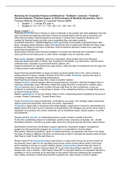Samenvatting
Corporate Finance and Behaviour UU ECB2 - Summary of All Material
- Vak
- Instelling
- Boek
Summary of all the material covered in the course ECB2FIN: Corporate Finance and Behaviour (year 2). This document includes a summary of the textbook (Brealey / Myers / Allen - Principles of Corporate Finance) and an explanation of the market efficiency theory and call / put options.
[Meer zien]




